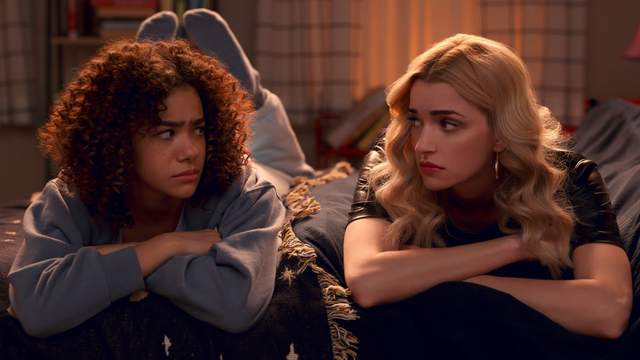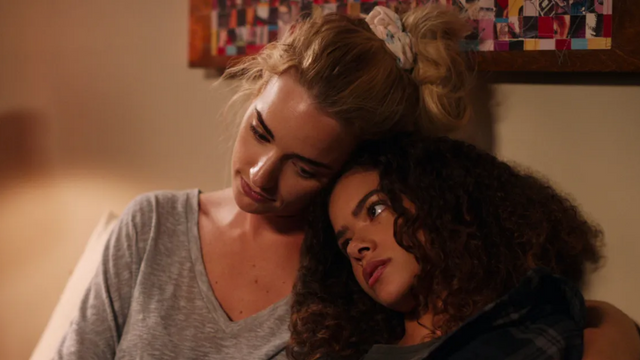Guy Fieri has a dish titled Trash Can Nachos, and the concept is as outrageous and likely as good as it sounds. It consists of more than a few layers of chips with toppings and melted shredded cheese.
It is a tower of tortilla chips constructed inside a huge metal container and covered with carne asada, beans, salsa, red onion, jalapeno, and Cotija cheese, and then soldered together with a roux-based cheese sauce consisting of four additional types of cheese and heavy cream.
It is undeniably nachos, but it is also so much more, crowd-pleasing but also divisive, and loaded with unnecessary ingredients. Except that if you removed something, it would become less of itself.
The new Netflix sitcom Ginny & Georgia reminds me most of trash can nachos. A woman named Georgia (Brianne Howey) with a troubled background and two children travels to a wealthy Massachusetts suburb for a fresh start in this hour-long drama.
READ MORE:
- Nope Review: Latest Horror Film From Jordan Peele is Not Your Typical Monster Movie
- Thor Love and Thunder Review: Taika Waititi’s Return to Marvel is a Disappointing Follow-up
Her daughter Ginny (Antonia Gentry) was born when Georgia was just 15 years old, and the mother-daughter relationship on Gilmore Girls is apparent.
Given the double-G hit of the title and the eccentric location of the town, it also appears calculated. The connection to Gilmore Girls is apparent, and Ginny & Georgia invites it, yet this is only one layer of what Ginny & Georgia is accomplishing.
It would be like attempting to describe Trash Can Nachos by stating, “Oh yes, they’re like most nachos you’d cook for yourself on a regular basis.”
Because Ginny & Georgia is about so much more than the tight relationship between an abnormally young mother and daughter. As the show investigates Georgia’s background, which is rife with illicit behaviour, Georgia begins concealing her tracks in the present, and the show becomes into a crime drama.
When Ginny begins to make friends at her new school, the show transitions to a light teen drama, but when they party hard and Ginny engages in horrific self-harm, the teen drama turns significantly darker.
When Georgia begins working for the town’s mayor (Scott Porter), the series becomes more of a local political comedy. Throughout, the series is largely impacted by Ginny and Georgia’s multiple love interests to which they are most attracted to, and in such passages, humor is infused with a strong dose of dark romance.
Oh, and Ginny has a younger brother named Austin (Diesel La Torraca) who is occasionally an endearing, socially uncomfortable Harry Potter lover and occasionally alarmingly comfortable with violent behavior.
Also included are Dare Me, Euphoria, Weeds, Sneaky Pete, Mom, Desperate Housewives, and How to Get Away with Murder, with a dash of We Need to Talk About Kevin and a Hart of Dixie twist.
Comparing a TV show to all the other shows it most like is lazy, and it tends to minimize what is most intriguing and distinctive about a new series. It’s a shortcut for illustrating commonplace stuff.
In the case of Ginny & Georgia, comparing it to other television programs is unavoidable, as the show excels at a variety of things but is not very adept at integrating them into a coherent whole.

From scene to scene, it is nearly difficult to predict what type of presentation it will be. Will this next scene with Georgia be more about a mother attempting to be wholesome but failing or more about a mother who doesn’t care about wholesomeness because she’s now embezzling?
Will the tone of this town council meeting be “these suburban residents are loving kooks” or “this is soul-crushing and boring”? It is a wild and surprising mixing of so many genres and tones that watching it often feels like being abruptly transferred from one television show to another, with no warning or explanation.
It resembles a Frankenstein monster composed of numerous other things, and if you look closely, you can still discern where each component came from.
It is an unbalanced and excessively long program that stutters toward the final episode. Nevertheless, Ginny & Georgia has a plethora of story threads to carry you through the season, assuming you overlook the large-scale structural issues and the question of why this nacho tower had to be constructed in such a large can with so many different cheeses.
Ginny and her three close friends (Sara Waisglass as Max, Katie Douglas as Abby, and Chelsea Clark as Norah) are their own little school drama engine. They hang out, quarrel, reconcile, and betray one another with a more regular and convincing rhythm than the majority of the series.
There are captivating moments where Ginny simply sits in her bedroom and texts her friends. Ginny is attempting to decipher one-on-one sidebar chats amidst a deluge of incoming messages into the group chat and a simultaneous barrage of SMS.
The group partying moments and an inevitable precursor and follow-up group quarrel scenes are the show’s most consistently interesting writing, particularly when it incorporates Ginny’s uneasiness with being the only Black kid or one of the other girls’ fears about their homes.
Ginny & Georgia’s “everything, all the time” inclination works best in the context of a high school, where it makes sense for a group of adolescents to be overwhelmed by a dozen various sources of sexual, emotional, and social tension, and to feel highly attentive to them at all times.
The sitcom also invests the most affection in its high schools clichés, such as the big school overnight, college application anxiety, the horrible racist teacher, and cliques.
I was delighted to see the return of one of my personal favorites, Hot Neighbor With Floppy Dark Hair Who Is Not Your Boyfriend But Sometimes Climbs Into Your Bedroom Window to Make Banter.
Ginny is also the easiest to sympathize with. She makes some poor choices and is occasionally harsh, but she has the most fascinating motivations for her actions, and she’s at the center of the best friendship, sex, class, and race stories in the program.
Georgia’s side of the equation is significantly more unstable. She is a character who is continually defending herself against charges that she is a bad mother, whether from the other mothers in town or from her love interests, her children, or people from her past.
MUST READ:
- Triangle of Sadness Review: How Long is the Vomit Scene in Triangle of Sadness?
- Rings of Power Review: Why Galadriel Did Not Tell Elrond About Halbrand?
Furthermore, she is frequently a poor mother. For example, she commits numerous crimes. Austin’s entire narrative involves him slashing a classmate, and Georgia barely takes notice.
She conceals information from Ginny in an attempt to protect her, which backfires in approximately seven ways. But the show can’t decide if it’s on Georgia’s side, or if she’s supposed to be a Breaking Bad–style antagonist who we sympathize with despite our better judgment.
Depending on what phase the program is in and who Georgia is harming in order to save her family, the mood shifts drastically. By the end of the season, Georgia’s serious issues are readily apparent. Whether Ginny and Georgia want us to hold them against her is considerably less clear.
Mr. Fieri created these Trash Can Nachos because there was a market for them, and even if you don’t like the overall presentation, you’re likely to enjoy at least a portion of these nachos.
This is also true for Ginny and Georgia. The entire product may be poorly planned and overstuffed, but there is so much going on that at least some of it must succeed.
